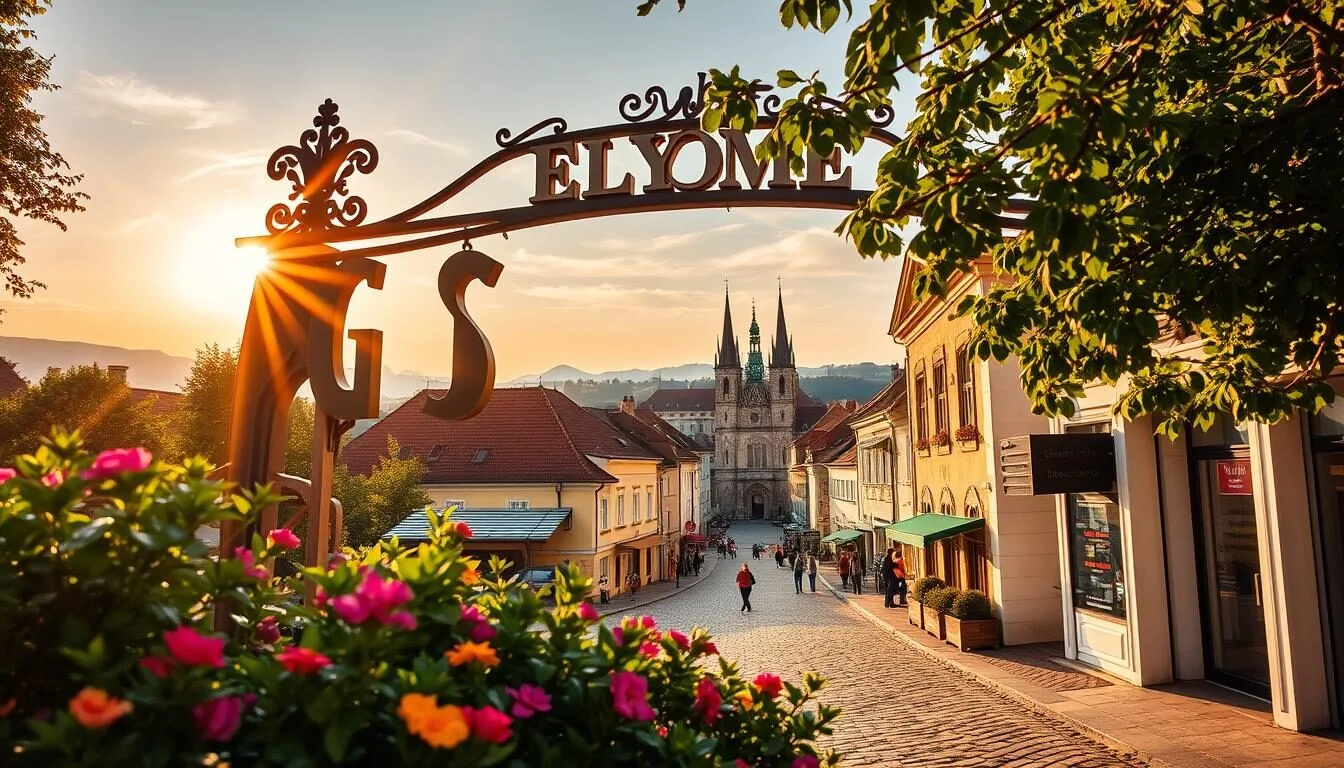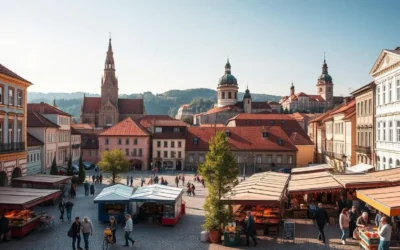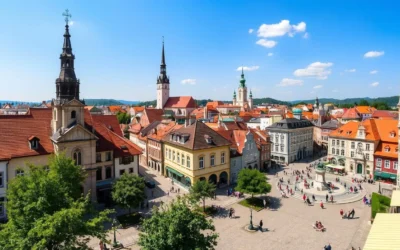Surprising fact: a direct train from Vienna reaches the city in about 1.5 hours, so you can go from one capital to cobbled streets and riverside benches within a single morning.
You’ll find a compact, walkable center that makes a relaxed visit easy. From the station, sights cluster close together so you can plan a single, satisfying day without rushing.
Expect practical tips on where to start, how to pace your route, and which squares and viewpoints give the best photos. The guide highlights the City Hall area, Káptalandomb, and other Baroque gems in clear order.
You’ll also get quick notes on family detours, short cultural stops, and smart times to see interiors with fewer crowds. By the end of this intro, you’ll know how to shape a smooth, photo-ready visit that balances must-see landmarks and slow riverside moments.
Why Győr Makes an Ideal Day Trip in Central Europe
Short travel times and a walkable core mean you can see rich architecture and still relax. The compact center keeps walking easy, so you spend less time moving and more time enjoying each stop.
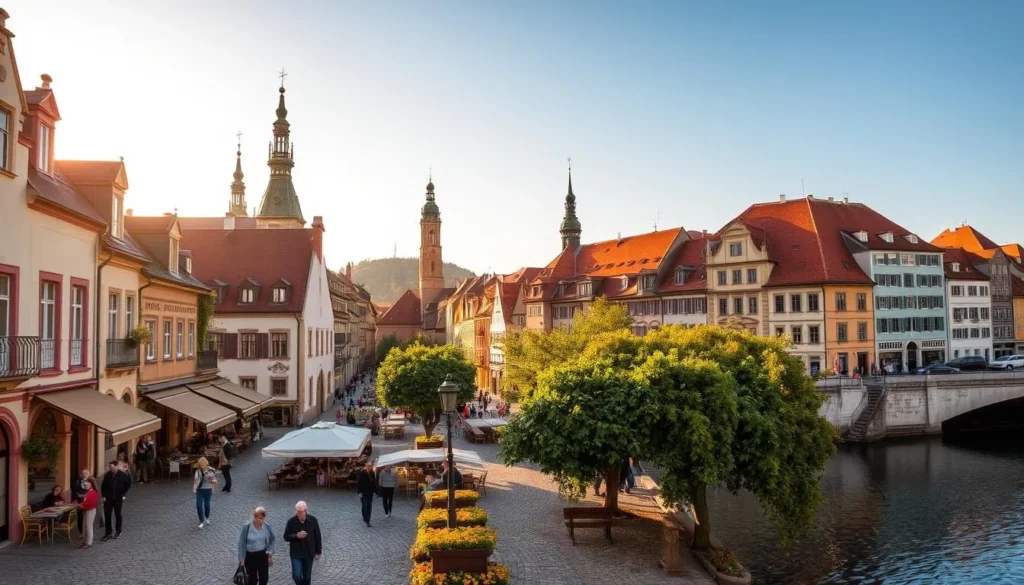
Compact, walkable, and crowd-light
The historic core is small and flat, so you can cover major squares, churches, and lookouts on foot. Light crowds let you linger at viewpoints and interiors without hurrying.
Start at the City Hall and loop toward Bécsi kapu tér for tidy pacing. Build in slow breaks at Széchenyi tér benches or along the riverbank.
Easy links from Vienna, Bratislava, and Budapest
Direct trains from Vienna (ÖBB/Railjet and RegioJet) take about 1h10–1h50; fares run €15–30 and tickets are not interchangeable between companies. From Bratislava, a direct FlixBus drops you behind the station in ~1h for under €10.
RegioJet from Budapest takes roughly 1h8–1h20 with fares near €6 one way. These quick options save you time and make this city a convenient stop for travelers based in nearby capitals.
Start at the City Hall and Győr Sign for an Iconic Photo
Begin at the neo-Baroque hall forecourt, where the large city sign sits just outside the station. The building spans 85 m and features a 59 m clock tower designed by Hübner Jenő in the 1890s.
Admire the architecture and take your picture before the morning crowd arrives. Step inside if the lobby is open to see Carrara marble statues of King Stephen V and József Bisinger.
This spot is a handy orientation point: Baross Gábor út runs north toward the river and the old town highlights. You can use the Town Hall as one of your main landmarks while exploring.
- Find the best angles for the facade and the sign to avoid traffic in your shot.
- Grab a quick espresso at nearby cafés and check restrooms before you set off.
- Seasonal flowers and festive decor add color to photos; note the top times for soft light in the morning.
Short on time? Combine this quick stop with a walk down Baross Gábor út toward Széchenyi tér for an efficient route into the old town.
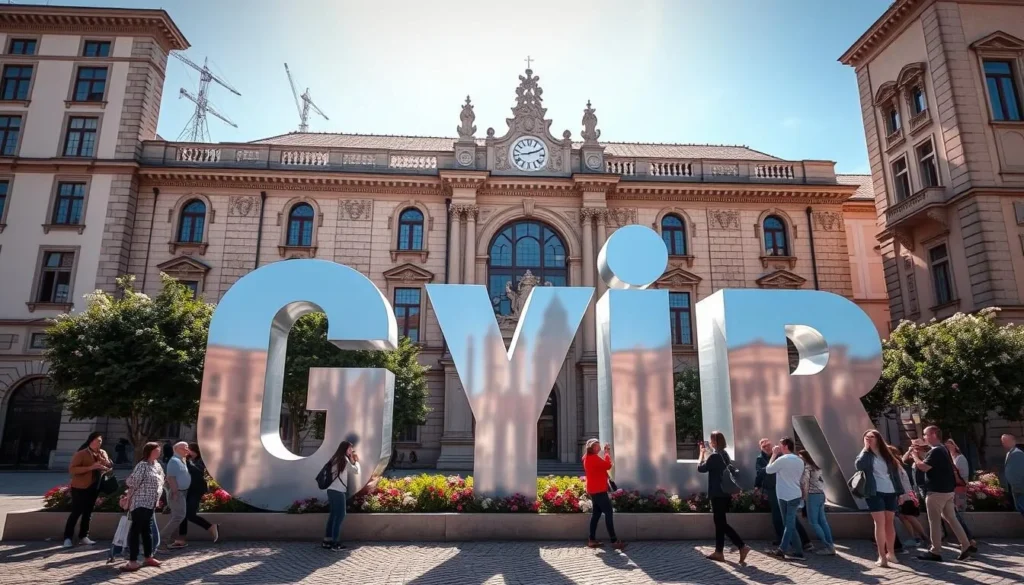
Wander Baross Gábor út: Flower-Filled Pedestrian Street
A stroll along Baross Gábor út gives you a quick, colorful taste of the old town’s daily rhythm.
Bright planters and sidewalk cafés line this pleasant street. Cobblestones set a relaxed pace, so you can slow down and look into shop windows.
Two playful statues—the Boy in a Boat and St. George’s Fountain—pop up along your route. They make handy photo stops and help you track progress toward the river.
Cafés, shops, and cobbled-street ambiance
Grab a mid-morning coffee at one of the terraces or sample pastries from a local bakery. Outdoor seating choices vary by sun and shade, so pick a bench that fits your timing.
- Pass boutiques and bars that give a taste of local life.
- Peek down side alleys if you enjoy wandering cobbled streets and quiet photo ops.
- Seasonal markets may add browsing time; winter markets bring extra stalls and lights.
| Feature | What to expect | Best timing |
|---|---|---|
| Flower displays | Colorful planters and window boxes | Morning and late afternoon for soft light |
| Cafés & bakeries | Outdoor tables, local pastries, espresso | Mid-morning for fewer crowds |
| Statues | Boy in a Boat, St. George’s Fountain | Anytime; great for quick photos |
| Shopping | Local boutiques and souvenir shops | Afternoon for relaxed browsing |
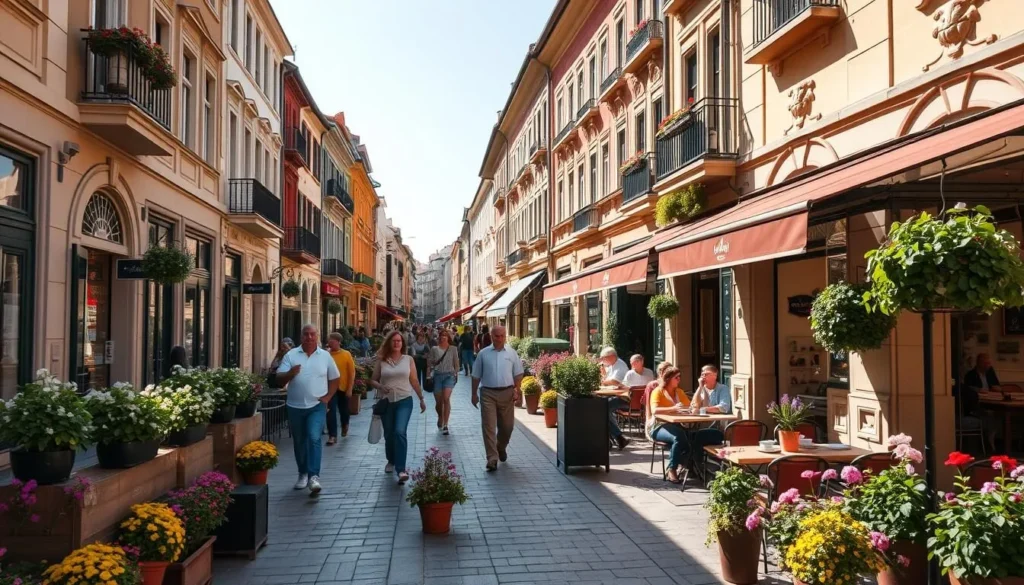
This stretch makes a smooth transition toward Káptalandomb or Széchenyi tér without backtracking. Save it for a lunch stop or a late-day drink when the light softens and the town feels even more inviting.
Hunt for Statues and Street Art Across the Old Town
A slow walk through the center reveals quirky statues and interactive pieces worth pausing for. Public art is scattered along main routes and tucked into quiet squares, so keep your camera ready.
The Boy in a Boat and St. George’s Fountain
Pause at the Boy in a Boat and St. George’s Fountain on Baross Gábor út for classic photo moments. These two statues are easy to reach and make a reliable spot on any short route.
Interactive mirror sculpture at Dunakapu tér
At Dunakapu tér, you’ll find a rotatable mirror sculpture that invites playful group shots and creative reflections. It’s a fun contrast to the town’s carved figures.
- You’ll find whimsical sculptures tucked into squares and along the main street—great for curious wanderers.
- Statues often sit near benches, so you can rest while framing a shot.
- Morning light gives cleaner photos and fewer passersby for clearer frames.
- Wrap up this loop and continue toward Káptalandomb to keep your route compact.
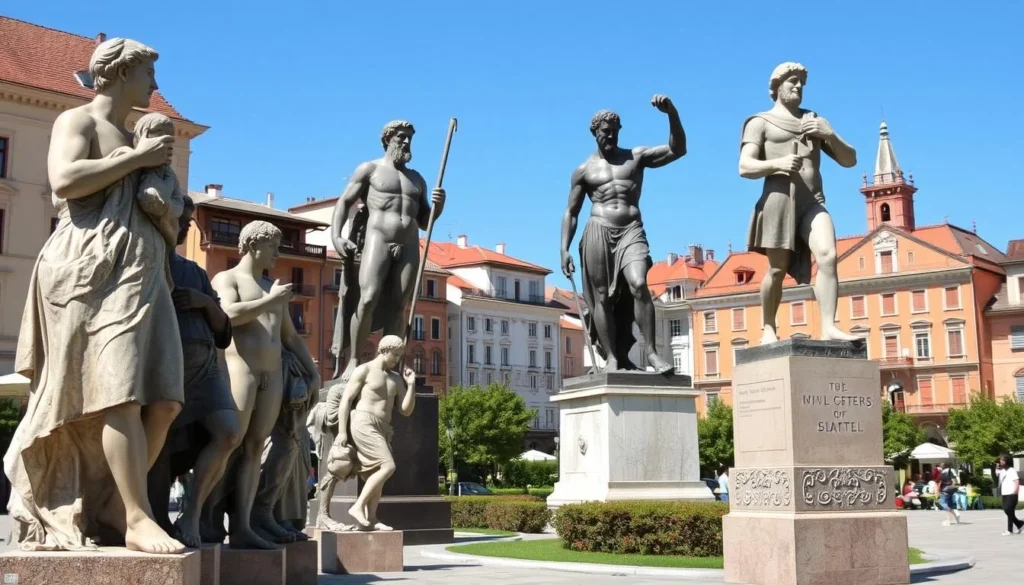
| Art piece | Location | Why visit |
|---|---|---|
| Boy in a Boat | Baross Gábor út | Iconic photo spot, easy access |
| St. George’s Fountain | Main pedestrian stretch | Classic sculpture, nearby cafés |
| Mirror sculpture | Dunakapu tér | Interactive reflections, group fun |
Explore Káptalandomb: Historic Heart of Győr
Climb Káptalan Hill for narrow lanes, Baroque facades, and a clear view where three rivers meet. This compact rise crowns the confluence of the Danube, Rába, and Rábca and feels like the city’s oldest patch.
Wander the cobbled lanes and you’ll notice layers of building styles—from Romanesque foundations to later Baroque dressing. The episcopal complex sits here: the Cathedral Basilica and the Püspökvár form a tight ensemble worth a slow look.

If you love doorways, courtyards, and stucco flourishes, this side of the center is rich in detail. Pause on narrow corners for quiet photos and stand at the right viewpoint for the best confluence shots.
- Climb into the oldest part for architecture details and river views.
- Follow a short, streamlined route that hits the main angles without wasting time.
- Duck into shaded arcades or the basilica if midday sun or rain arrives.
| Feature | Where to stand | Quick note |
|---|---|---|
| Episcopal complex | Forecourt of the basilica | Look for layered fortification and Baroque facades |
| Confluence view | Small lookout near the palace side | Best in morning light for clearer river lines |
| Photogenic lanes | East-facing alleys off the main square | Great for doorways and stucco details |
| Quick route | Loop from the basilica toward the Bishop’s Tower | Pairs well with a later tower climb for skyline context |
Short on time? Take the streamlined loop noted above. You’ll cover key history, admire architecture, and still save energy for a tower view or riverside break. These are the small things that give the town its big character.
Cathedral Basilica and Bishop’s Castle-Tower Lookout
Step inside the cathedral for a calm encounter with frescoed ceilings and layered architecture before the daytime crowd arrives.
Origins matter: the building grew from an 11th-century foundation, was razed in 1241, and later rebuilt after Ottoman times. Inside, altars carved in Vienna and Franz Anton Maulbertsch frescoes catch the eye.

Cathedral highlights
Look for the Gothic Héderváry Chapel (1404) with the Herm of Saint Ladislaus and the revered Weeping Madonna. Interpretive signs point out context for each piece of sacred art.
If you love churches, note the mix of Romanesque remains and Baroque finishes. A quick checklist helps if you have limited time:
- Frescoed ceilings and main altars (enter early).
- Héderváry Chapel and national relics.
- Weeping Madonna and nearby labels for art context.
Climb the Bishop’s Tower
Cross to the Bishop’s Castle-Tower for a ticketed climb. The tower requires a staircase ascent and a small ticket fee, payable on-site. From the top, you can trace your walking route across rooftops and spot the National Theatre silhouette.
| Visit step | What to expect | Best time |
|---|---|---|
| Cathedral entrance | Free entry to the nave and chapels | Early morning for quieter views |
| Bishop’s Tower | Paid climb; narrow steps; skyline vistas | Late morning to catch good light |
| Guided palace tours | Hourly on Tue–Sun | Check schedule on arrival |
Timing tip: enter the cathedral first, then climb the tower second. This sequence balances light, crowds, and the best views for photos.
Széchenyi tér: Benches, People-Watching, and the Benedictine Church of Saint Ignatius
Drop onto a bench at Széchenyi tér and watch life unfold. The square has long served as the market and event heart of the old center.
Take a breather and people-watch: pastel facades, a central column, and steady foot traffic make this an ideal spot to rest and plan your next move.
Step inside the benedictine church saint for a quick look. The church saint ignatius is modeled on Rome’s Gesù and shows lavish 18th-century decoration by Paul Troger.
This Italianate plan is an excellent example of early Baroque sacred space in the region. If you love sacred art, note Troger’s frescoes and the organ details.
’ll also find the Vastuskós (Iron Stump) House at No. 4. Look for the nail-studded trunk tied to old good-luck traditions.
Circle the square to admire fine Baroque buildings and the Column of Saint Mary (1686), which marks key moments in local history.
- Best quick photo: pick the corner that frames the church and the Column together.
- Timing tip: place this stop between the cathedral and Bécsi kapu tér for smooth routing.
- Market or festival? Outdoor stalls change the scene—great for snacks and street art hunting.
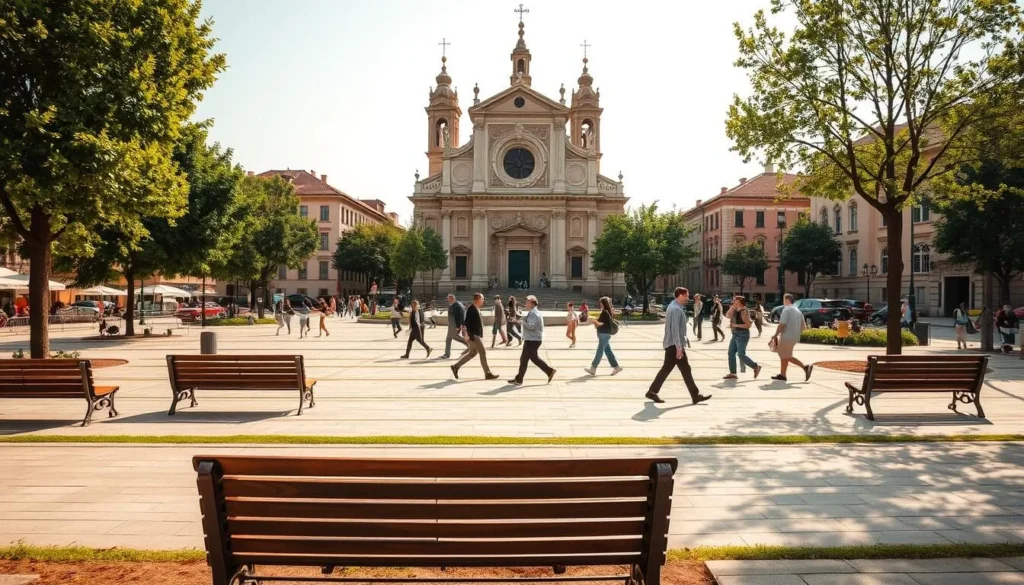
| Feature | Why visit | Quick tip |
|---|---|---|
| Benedictine Church of Saint Ignatius | Troger frescoes; Gesù-inspired interior | Enter briefly for photos and the organ case |
| Vastuskós House | Nail-studded stump tradition | Find No. 4 for a close view |
| Column of Saint Mary | Commemorates historic events (1686) | Good central landmark for meeting |
| Benches & cafés | People-watching and outdoor seating | Choose shaded benches in midday |
Secret Spots: Tiny Doors at Lépcső köz and Trade Signs on Gutenberg Square
Slip into Lépcső köz and hunt for tiny doors built into the steps near a shop entrance. These small features are easy to miss, and spotting one feels like finding a secret in the city.
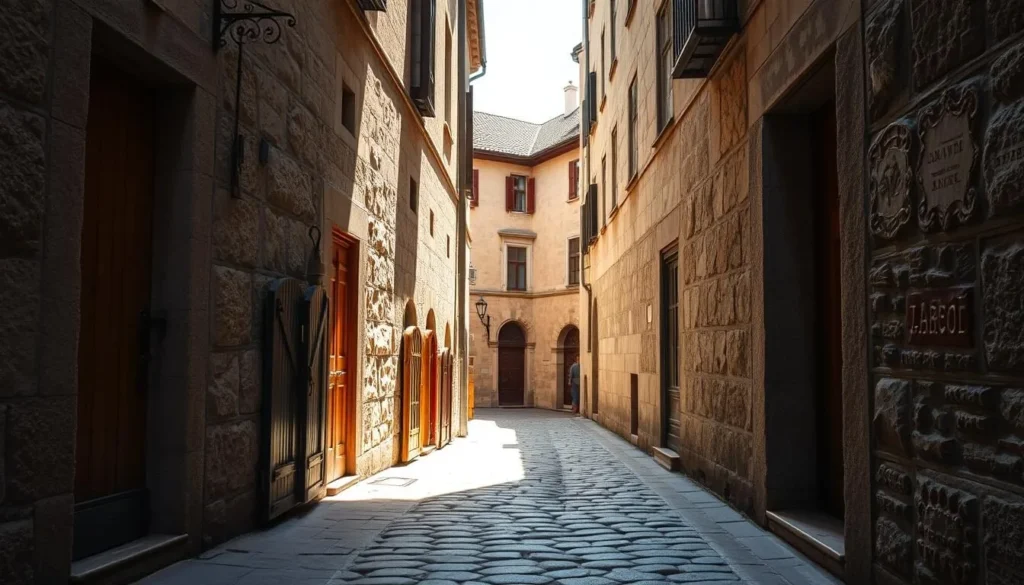
On Gutenberg Square, look up at the façades and you’ll find historic trade signs. The Golden Ship sign stands out among the old metal emblems above shops.
Visit the Kreszta House for the Margit Kovács ceramic collection. It’s a compact art stop that rewards a short detour and complements nearby architectural details.
- Hunt tiny doors at Lépcső köz—great for close-up photos.
- Scan building facades on Gutenberg Square for trade signs like the Golden Ship.
- Learn about Ányos Jedlik’s soda-water siphon and how the local fröccs spritzer came to be.
- Pause at nearby cafés to map a quick loop toward the riverside or Káptalandomb.
| Spot | What you’ll find | Best time |
|---|---|---|
| Lépcső köz | Tiny doors in stair risers near a shop | Morning or late afternoon for soft light |
| Gutenberg Square | Historic trade signs; Golden Ship | Quiet hours to avoid crowds in photos |
| Kreszta House | Margit Kovács ceramic collection | Midday when small museums are open |
| Nearby cafés | Rest and detail spotting | Anytime; good for a relaxed search |
Step into the Synagogue of Győr: History, Concerts, and Limited Opening Hours
A short detour brings you to a striking 19th-century Neolog synagogue crowned by a wide gray dome. The building’s octagonal plan creates a calm, symmetrical interior that catches light beautifully.
Practical entrance info: opening hours can be limited and change with events. Expect a small ticket or donation on arrival, though fees are sometimes waived for rehearsals or student practice.
What to look for inside
Look up to take in the dome, galleries, and clean lines of the plan. The symmetry and decorative details reveal the building’s layered history and architectural care.
- Check hours before you go—times may vary with concerts or festivals like Mediawave.
- Consider timing your visit to catch a performance; concerts make the space come alive and need no translation.
- There’s a small, well-kept Jewish cemetery behind the synagogue if you want deeper history.
| Feature | Why it matters | Quick tip |
|---|---|---|
| Architecture | Octagonal plan, dome, galleries | Photograph vertical lines for volume |
| Concerts | Regular cultural events, including festivals | Align visit with performance times |
| Entrance | Small ticket or donation typical | Bring local currency and check time |
Plan a short visit unless you attend a concert. You can easily fit this stop between Széchenyi tér and the riverside for a balanced city route.
Riverside Strolls and Radó Island: Peaceful Green Escape
Swap cobbles for green grass and follow riverside paths that calm the pace of your day.
Walk the riverbank for a quiet reset in the middle of your city route. Benches and lawns appear often, so you can sit, snack, or watch boats glide by.
Cross the footbridge to Radó Island for leafy paths, WWI memorials, and a softer, nature-forward side. The island feels like a small park with easy, stroller-friendly trails.
Families will like the open space and safe paths where kids can wander a bit while you relax. Pack a picnic or grab takeout nearby and make this your midday pause.
For photos, frame bridges and domes from the water’s edge. Time your stop for golden hour if you want warm light and mirror-like reflections on the river.
If you’re on a short day trip, this spot adds variety beyond churches and squares. Use the nearby bridges to loop back toward Bécsi kapu tér without adding extra steps and decide then if you’ll visit the thermal bath later.
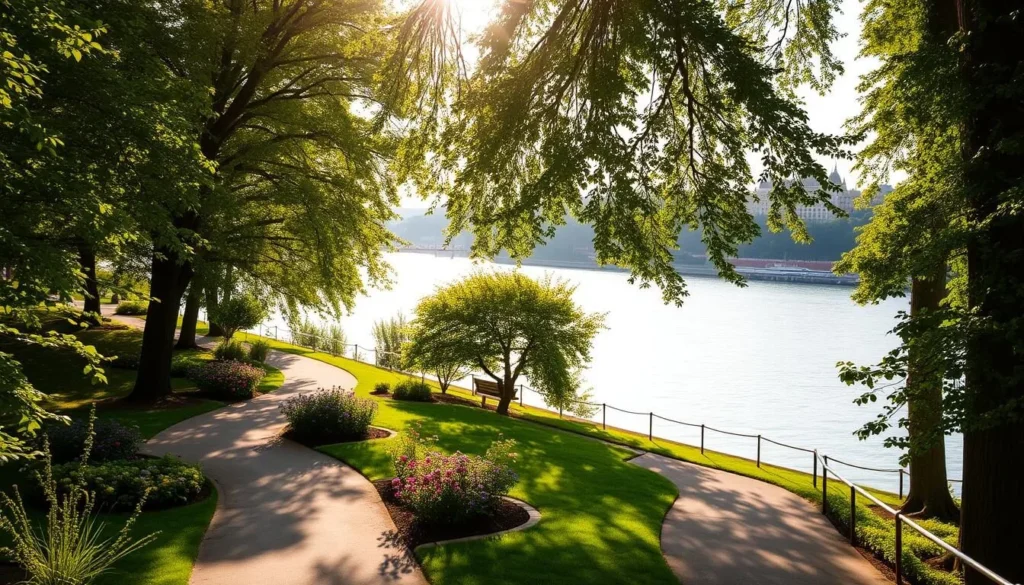
| Feature | Why visit | Best time |
|---|---|---|
| River benches & lawns | Rest, people-watch, picnic | Midday or late afternoon |
| Radó Island paths | Leafy walk, memorials, calm | Anytime; shady in summer |
| Photo angles | Bridges, domes, reflections | Golden hour for best light |
Bécsi kapu tér: Carmelite Church, Clock Tower, and Casemates
Bécsi kapu tér holds a compact slice of fortress history and Baroque flair right at the river edge.
Step into the square and you’ll see the Carmelite church with its onion-domed tower and statues by Diego Carlone. Inside, altarpieces by Martino Altomonte reward a quick stop and quiet photos.
Scan the Óratorony clock tower — it doubles as a quirky temperature display that punctuates the skyline. Benches and river access make this a good place for a pause.
Vienna Gate heritage and fortress remnants
The old Vienna Gate was damaged in 1809 and demolished in 1860, but you’ll still find traces of the 16th-century ramparts. These defenses shaped the town’s history and remain legible in low walls and alignments.
Castle Casemates & Lapidarium: stones, steles, and fragments
Duck into the Castle Casemates & Lapidarium to see fragments from that triumphal-arch-style gate, plus Roman-era steles, sarcophagi, and reused bricks. A tourist train sometimes departs nearby, making this a handy stop on a short route.
- Photo tip: frame the church facade with the riverfront for layered compositions.
- You’ll also find carved volutes and pilasters that define the square’s Baroque architecture and local art.
- You’ll find a Mary statue inside the church linked to flood lore—look for side altars and small plaques.
| Feature | What to see | Quick tip |
|---|---|---|
| Carmelite church | Onion dome, Carlone statues, Altomonte altarpieces | Enter briefly for side-altars and the Mary statue |
| Óratorony | Clock face; temperature display | Good landmark for meeting or orientation |
| Casemates & Lapidarium | Gate fragments, Roman steles, sarcophagi | Best in dry weather for clear photos |
| Square access | Benches, river edge, tourist train stop | Perfect for a short break before Radó Island |
Győr, Hungary: Best Things to Do – Top Picks at the National Theatre and Beyond
From the Bishop’s Tower you can read the theatre’s half-pipe roof clearly across the old skyline. That view makes the modern building feel like a bridge between eras.
Theatre up close is a sculptural design that resists a single angle. Walk around the building to photograph curves, corners, and the way it plays with light at dusk.
If performance art interests you, you also want check the calendar for ballet and concerts that work despite language. Tickets are often budget-friendly, and matinees free up your afternoon for more city attractions.
- Best vantage: Bishop’s Tower for the half-pipe shape.
- Quick visit: circle the façade and snap wide and close shots.
- Booking tip: buy on-site on performance days for low-cost seats.
| What | Why visit | How it fits your time |
|---|---|---|
| Photographing the theatre | Unique modern art and form | 10–20 minutes for a solid set of shots |
| See a show | Drama, ballet, and music programming | Matinee or evening options; plan 2–3 hours |
| Nearby attractions | Squares, riverside walks, and museums | Pair with an evening performance for cohesion |
Soak and Unwind: RQ Vízi Élménypark és Gyógyfürdő Thermal Bath
Cap your day with a restorative visit to the RQ thermal complex. You can pick a calm, textile-free sauna zone or the livelier family pool area with slides and warm pools.
The split setup means adults seeking quiet can choose the sauna spaces, while families find slides and shallow pools in the other section. On chilly afternoons, a soak feels especially cozy after a long walk.
Practical tips for your visit
- Buy a single ticket at the counter or online; check which zone it covers before you enter.
- Expect staff to check entrance policies during busy hours; bring ID if needed.
- Lockers and showers are on-site—flip-flops, a water bottle, and a towel make things easier.
- If you want quiet, aim for later in the day; families often go early evening or weekends.
- Pair the bath with a nearby dinner to keep logistics simple and warm after your soak.
| Area | Who it suits | Best time |
|---|---|---|
| Textile-free sauna zone | Adults seeking quiet | Late evening on weekdays |
| Family pool area | Parents and children | Afternoon to early evening |
| Facilities | Lockers, showers, refreshments | Available during open hours |
If you’re not a spa person, consider a riverside walk or a relaxed café after sunset as an alternative. Either way, this thermal stop is an easy, local way to end your city day refreshed.
How to Get to Győr and How Much Time You Need
A smart morning train or bus sets you up to see the highlights without panic.
From Vienna: direct ÖBB/Railjet and RegioJet services run in about 1h10–1h50. Fares are typically €15–30. Important: tickets aren’t interchangeable between carriers—confirm which operator before you board.
From Bratislava: a direct FlixBus takes roughly an hour and stops right behind the station. Expect fares under €10 and a short walk into the center.
From Budapest: RegioJet trains from Déli or Kelenföld run about 1h8–1h20 with fares near €6. The station is a short walk to the old core, so you’ll be on foot quickly.
One‑Day Route and Pacing
For a smooth day trip, follow this loop: City Hall → Baross Gábor út → Káptalandomb → Széchenyi tér → Bécsi kapu tér → riverside. Allocate about 45–60 minutes for major stops and 15–30 minutes for coffee breaks.
- Book a return ticket if you have tight time windows.
- Also want check live schedules on travel day for minor timing shifts and platform updates.
- If you stay into evening, add dinner near the river and choose a later return train.
With these logistics sorted, this city makes an ideal day trip destination from nearby capitals and gives you plenty to visit in one relaxed day.
Where to Eat: Coffee, Cakes, Vegan Bites, and Local Favorites
Local cafés deliver strong coffee, vegan options, and sweet treats near every stop. Plan your food breaks around Széchenyi tér or Bécsi kapu tér to keep your route efficient and bite-sized.
Vegan-friendly picks
Vital Cafe & Bistro is the only 100% vegan spot; expect daily specials and cakes. Café Frei also offers several vegan cakes and specialty lattes if you want variety.
For savory vegan wins, try Csicseri for falafel or Morzsa for bowls and sandwiches—both sit conveniently near the old town route.
Traditional flavors and quick sweets
If you crave classic local lunch value, Szalai Vendéglo serves a wallet-friendly daily menu that usually includes soup. For dessert, you’ll find rétes (strudel) shops scattered around the center.
- Families can pick quick counter-service spots to keep kids fueled without long waits.
- If you’re short on time, grab takeout and eat riverside or on Radó Island.
- Also want check opening hours—some kitchens close midafternoon or on Sundays.
| Spot | Why visit | Quick tip |
|---|---|---|
| Vital Cafe & Bistro | 100% vegan mains and cakes | Try a daily special |
| Café Frei | Vegan sweets and lattes | Good for coffee and dessert |
| Szalai Vendéglo | Traditional daily menu | Value lunch with soup |
Conclusion
Wrap up the day with a short circuit through landmark streets, a tower view, and a relaxed riverside bench. This pace keeps the route gentle and photo-friendly.
You’ll leave with a clear sense of history from the Cathedral Basilica and Bishop’s Tower, plus the fortress traces at bécsi kapu tér. The old town’s squares, statues, and lively street corners reward slow walks.
Families can mix river play with quick interior stops, then finish with a thermal soak or a performance at the National Theatre. In one compact visit, the city’s architecture and small‑scale charms add up to a memorable day trip destination.
The above is subject to change.
Check back often to TRAVEL.COM for the latest travel tips and deals.
